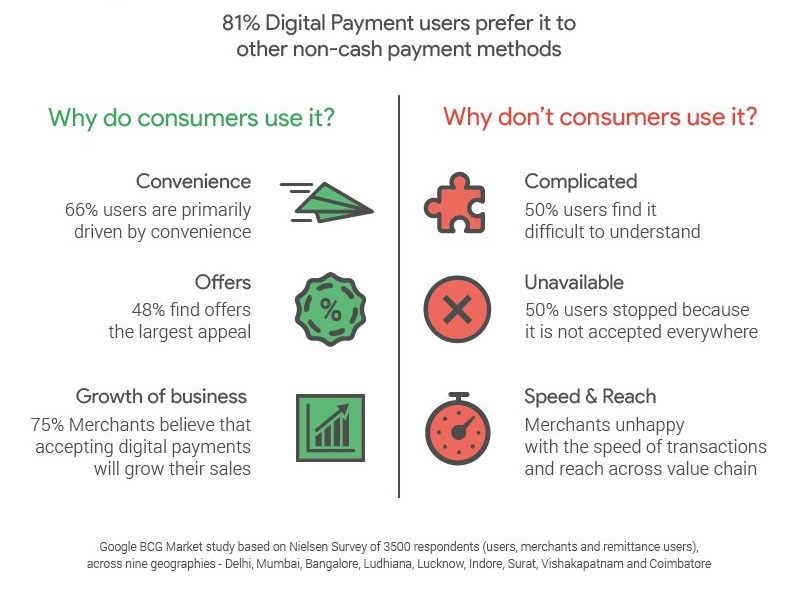Over the last 50 years, the rapid proliferation of electronic payments—in particular credit, debit and prepaid cards—has changed how consumers pay for goods and services, how merchants manage their businesses, and how governments make and collect all sorts of payments. India is set for a digital payment revolution and the overall payments landscape of the country is up for a complete overhaul. The payments landscape in India is at a point of inflection with growing acceptance infrastructure and consumer adoption of digital payments. Continued government initiatives to drive e-payments, including fiscal incentives for consumers and merchants to switch from cash, efforts to bolster financial inclusion, and a focus on innovation are necessary to drive change. The digital payments industry in India are expected to hit $500 billion by 2020, contributing 15 per cent to the country’s GDP, according to the latest ‘Digital Payments 2020’ report by Google and Boston Consulting Group (BCG).
The key driver behind this is, efforts by both government and industry to boost financial inclusion in India. The government has made the move away from cash, a key pillar of its finance strategy.
The demonetization move, and the subsequent cash crunch, has in turn led to a surge in digital payment banks. Even as a number of policies and tools were already present to encourage digital mode for making payments, the November 8, 2016 announcement became a key driver to boost the cashless system.

According to the ‘Digital Payments 2020’ report, the growth of the Indian digital payments space is expected to be driven the following mega trends that are also likely to impact the future of this industry:
- The first trend is India going digital which is reflected in the rising smartphone penetration and Internet access, which translates into the growth of digital banking transactions. India currently ranks second in the world with over 1 billion mobile subscriptions, out of which about 240 million consumers use smartphones and this base is projected to increase to over 520 million by 2020.
- In the past 3-4 years, India has seen the emergence of a string of next-generation payment service providers spanning across sectors — Telco’s, banks, wallet companies, and e-commerce/tech firms.
In the past, banks have largely offered mobile banking apps with integrated bill payment solutions. However, customer experiences with mobile wallets have proved to be far more seamless and quick, leading to customers preferring wallets for mobile recharge and bill payments.
Text Messaging increases adoption of Prepaid Wallets and Payment Banks in Emerging Markets:
- Prepaid wallets came into existence around 2009-10 in the form of app-based mobile wallets where one can store a certain amount in their account funded through credit/debit cards or net banking. SMS has been the most used channel of communication by BFSI brands during demonetization. Brands in this segment have turned to app notifications and SMS as mediums to effectively engage with their consumers. They are also moving towards a multichannel approach where they communicate through a combination of social media channels, email, SMS and push notifications. For example, BFSI brands can engage customers for payment bank transactions like receive Emails to remind the customer to submit any remaining KYC documents for registration, receive customer onboarding emails to welcome customers and inform them about other products, receive offers and discounts available for all customers through transactional and promotional SMS’s, etc.
- Payment Banks- A payments bank is like any other bank, but operating on a smaller scale without involving any credit risk. In simple words, it can carry out most banking operations but can’t advance loans or issue credit cards. As more people use these services, their digital footprint could help other formal lenders such as established banks discover their creditworthiness, making it possible for the poor to get loans. For this process to be more effective, SMS is the best possible solution as the main objective of the government is to help the poor get access to banking facilities. Since most of them would not be owning smartphones, push SMS’s will be able to tap those markets. Another marketing tool used by the BFSI sector to better engage with consumers from rural markets, has been the automated voice IVR platform available in various regional languages for better reach. As Paytm and its rivals such as One Mobikwik Systems expand its services, tapping into India’s Aadhaar unique ID-based authentication, a billion people could benefit.
- Finally, enhanced customer experience will be a key driver for consumers to adopt the digital payment revolution. Indian customers are now used to a superior experience owing to the popularity of e-commerce, and are demanding a similar experience from their financial services providers as well. This includes seamless access to bank accounts and payments, coupled with rewards, loyalties, and offers communicated through various channels like SMS, Email etc

References:
- The Rise of Digital Payments
- Google’s BCG market study




